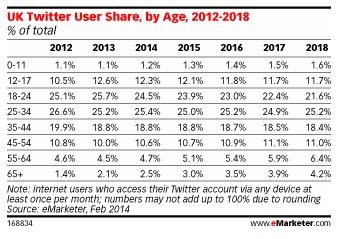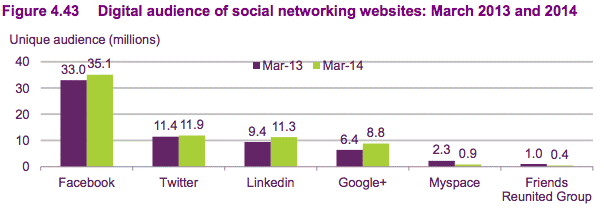How To Build A Social Media Strategy Template For Your Business
Before you start using social media in your business, it’s a good idea to have a plan.
A social media strategy is vital for brand awareness and will improve communication between your business and consumers. Here are 5 steps to guide you toward creating a social media strategy template that works for you.
Social media have become mass influencers in the online environment. According to businessculture.org, social media are increasingly being used by SMEs in the UK to boost their brand awareness. The most popular networks include Twitter, LinkedIn and Facebook.
Social media are powerful marketing tools to increase interactions between your brand and your consumer.
By sparking meaningful conversations and interactions online, your brand will be able to gain positive exposure and engagement, increase traffic to your site and ultimately increase sales. An effective social media template gives you the opportunity to add value to your customers’ online experience.
This article guides you in developing a template for your social media strategy in order to promote and sell your products and services online more effectively.
Follow these 5 quick and easy steps.

Image sourced from: rosemcgrory.co.uk
Social Media for SMEs
Whether you’re an entrepreneur or own a small business, the wide range of social media networking sites can help increase your website’s visibility amongst your target market. You can use social media to:
- Increase traffic to your webpage.
- Increase conversions.
- Improve customer retention and customer service.
- Create brand awareness.
- Develop positive associations around your brand.
- Encourage discussions about your business or website, and
- Attract followers, fans and friends to further promote your brand.
Step 1. Determine Your Social Media Goals and Objectives
You need to clarify your social media goals and align them with your business goals, then break it down into measurable objectives. Read through the list below and see which of these you can apply to your own social media marketing plan:
- Create awareness and enhancing your company brand.
- Build a relationship with your audience, so they can learn to trust you.
- Grow a positive online community/following.
- Increase visits to your website.
- Overcome objections and increase conversions.
- Create loyal visitors who frequently visit your site.
- Improve retention.

Image source: socialmedialondon.co.uk
Once you’ve decided on a particular focus, you need to set SMART objectives to reach those goals.
- Be specific: The more specific your objectives, the easier it will be to clearly define what it is that you need to accomplish.
- Make it measurable: It’s important that you have the right tools in place to track your progress on selected metrics.
- Achievable goals: Your social media goals need to challenge you, but not stress you out. Be realistic about what you can achieve with the resources you have available.
- Relevant and result-focused: You need a goal that has the potential to impact your business objectives, vision and values in a positive and appropriate way.
- Time-bound: Ensure you set a realistic time frame for meeting your goals.
Step 2. Who is Your Target Audience?
Now that you know what you want to achieve, it’s essential to determine the prospects and customers whom you actually want to attract and engage with.
A successful social media strategy is largely dependent on getting the right message to the right people. To do this, you need to understand your audience.
Read our buyer personas article to determine who your specific target market is and how you can influence their buying journey.
Step 3. Choosing a Social Media Platform
There are a variety of social media platforms to choose from. The ones you choose should fit with your customer personas.
Each platform has certain unique features. We’ll go through the Big 5:
#1 Facebook is by far the most popular network, with about 1.28 billion users, according to blog.digitalinsights.in.
Besides individuals who create personal Facebook profiles, brands and businesses use the platform to create fan pages and share content, while engaging with customers on relevant and interesting topics.
If you’re going to use Facebook, your goal should focus on letting customers get to know the people behind the logo.
“You’ll want to portray your business in a friendly, ‘sociable’ manner, as a place where customers are treated well and ‘everybody knows your name’, says Entrepreneur.com
When using Facebook as one of your social media platforms, consider the following:
- Brand yourself visually: Use a compelling profile picture and post fun company photos often and with enthusiasm. When sharing links or relevant content with your customers, always try to include some visual elements.
- Keep it short and simple: Posts should only be between 100-150 characters long.
- Maintain a consistent tone and style: Maintain consistency so your customers can get used to your voice and brand.

Image Source: montfrot.io/uk
#2 Twitter has approximately 225 million users, according to expandedramblings.com. Twitter allows users to compile 140-character messages known as “tweets”.
Engagement with brands on Twitter can increase publicity and drive more traffic to your site and content. To get the most value from your Twitter account:
- Be clear and concise: Write short, punchy messages when communicating with followers.
- Use relevant hashtags: Hashtags (#) are a way to categorise content, so users can participate in and share information on a particular topic.
- Offer users real-time updates: With Twitter you can spread news and information fast. Making it the ideal platform if you’re launching a new product or service and want to get the word out quickly.
#3 LinkedIn is the largest social media network for business people and professionals, a far more serious platform than Facebook or Twitter. LinkedIn also includes groups and discussions that drive engagement and interactions. Read our blog on using LinkedIn for business.
Create value for your brand by using LinkedIn groups to their fullest potential:
- Feature the group on your company’s website, blog or other social media platforms.
- Gain trust from your members by leading the group. Post weekly questions, run a LinkedIn poll, or comment on an existing discussion.
- Share useful content and offer advice.
#4 Pinterest is an image-based sharing platform where users create and contribute visual content by pinning it to a virtual board.
Businesses that will benefit the most from using Pinterest include online retailers, wedding planners, travel companies, interior decorators, and the fashion and food industry. Here are some tips, from socialmediaexaminer.com, when using Pinterest for your business:
- Share from a combination of sources, preferably from your compiled list of industry influencers.
- Use group boards and collaborate with popular pinners who have a large following.
Combine great images with content that solves problems.

Image Source: designinfographics.com
#5 Google+ is Google’s social media platform and is very similar to that of Facebook. Unbounce.com stated that with more than 540 million monthly users, Google+ should not be ignored.
- Google+ Circles allow you to organise your member base according to specific groups. This enables you to share content and information with targeted groups and keep the conversation relevant and engaging.
- Google+ Hangouts allows users to communicate face-to-face, essentially a video conference call. Your brand or business can host a Hangout video session or you can join other users’ Hangouts. This is ideal for building customer relations, hosting competitions or consulting with your team members.
- Google+ Communities is a group of people on Google+ with a shared interest in a particular field or topic, similar to LinkedIn groups. Listen to members of your community to find out what people think of your brand’s services and products.
Step 4. Types of Content You Want to Share
Decide on the type of content you want to share with your audiences.
Long-form articles
Long-form articles keep visitors on your site longer and increase engagement. This type of content will establish your credibility and leadership.
Listicles
An article presented in the form of a numbered or bulleted list. E.g. 5 Ways to Remove Carpet Stains. Pick a topic, then pick a number and use simple formatting.
- Introduce the topic.
- List your points.
- Provide conclusion.
How to’s and guides
Write top-tier content and present it in an attractive way. Your guides must be about something your audience wants and should be downloadable as a PDF. This is a great way to grow your mailing list. E.g. “You can have this awesome guide when you register your email address”.
Product reviews
Product reviews can help establish authority and leadership in your industry. When you engage key developers, manufacturers, and service providers, you gain recognition and respect. You need to share your experiences of the product and provide recommendations:
- Introduce the product.
- Introduce the producer/manufacturer.
- Describe the product.
- Share what you like.
- Share what you don’t like.
- Provide recommendations.
- Provide a call-to-action.
Infographics
The presentation of information or data in a visual way. Perfect for communicating data, research, statistics, and findings.
Videos
Done well, a video can be extraordinarily persuasive.
- You’ll need a script
- Place it on video sharing sites like YouTube and Vimeo
Take a look at our video marketing tips and tricks to boost leads and sales.
Step 5. Measurements and Metrics
It’s important to know what you need to track in order to know how your content and social media strategy is affecting your audience and your sales.
Use Google Analytics and turn your data into decisions:
- What’s working?
- How well is it working?
- What actions should be taken next?

Image source: Socialmediaexaminer
When using Google Analytics as your data source, there are four categories of reports we suggest you follow.
Each one is a key to understanding certain insights that impact the performance of your social media strategy:
- Audience reports: Dig deeper into your understanding of who your audience members are, what content interests them, and how they share it with friends.
- Acquisition reports: Get insights on the keywords your visitors are using to discover your content, and use these words in your social media messages.
- Behaviour reports: Uncover ways you can optimise engagement.
- Conversion reports: Determine if your social media content is helping your business achieve its marketing goals, and discover which networks are achieving the best results.
Conclusion
When developing a social media strategy make sure your social media goals are aligned with your business goals. Know your target audience by crafting individual brand personalities and use these personas to select your social media platforms and the types of content you want to share.
Google analytics will then guide you in adjusting your strategy to optimise engagement and achieve marketing success.
We hope you have enjoyed this article. If you have anything you’d like to add or any questions regarding social media strategies, please post a comment in the provided section below. We value your insights.
Discover
The 12 Marketing Secrets of Fast-Growth Companies
Find out what they do to achieve outrageous business success

Get your free copy

 By
By 
Social media marketing certainly helps attracting the potential buyers, increasing sales, and making money quickly, but it never recommended buying followers unethically. It is not going to increase web visibility or enhancing sales.